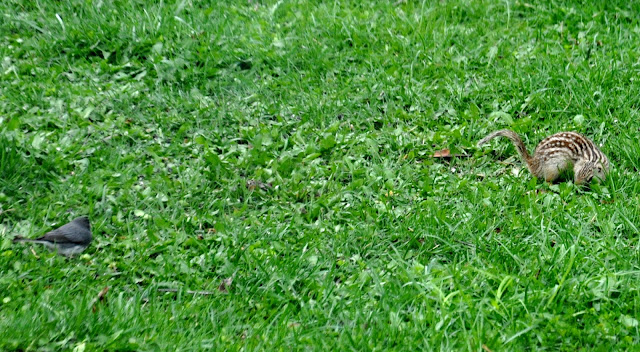Crop of original photo (see next post down) courtesy of palemale.com
Ohio Red-tailed Hawk maven John Blakeman on the possible reasons that the tail of Pale Male's mate Zena has unusual markings and is missing some of the "normal" ones--
Donna,
The horizontal stripe on Zena's tail feather is known as a "hunger trace."
It can occur for two reasons. Most often, especially in eyasses (seen in
immature hawks, before they have molted to adult plumage in their second
summers), hunger traces are from actual hunger, periods of time when the eyass
failed to eat enough food to fully grow emerging feathers while on the
nest.
Feathers are pure protein. An eyass going a day or longer without food will
have hunger traces in all developing feathers. Most eyasses have minor,
insignificant hunger traces in just the smaller parts of the feathers, not the
quills. These are insignificant.
But a strong hunger trace that creates a weakness in the shaft of the
feather is ominous. The feather is weak and can later break off. The hawk cannot
recover from this and will not be able to fly. It will starve.
The second cause---perhaps---is a fright response to lightning in
thunderstorms. You can imagine, perhaps, the sounds, heat, and light when a
lightning bolt strikes a nearby tree. Hunger traces are clearly caused by
hunger, but perhaps also by lightning-induced fright.
Zena's hunger trace has not caused any problems, as the entire tail feather
remains intact and fully functional.
In haggards (adults), hunger traces occur only on the feathers developing
at the time the trace occurs, which, then, is only in a few flight feathers. A
two-day strong rain and storm period could keep the bird from eating. Or, a
lightning strike in a roost-tree in August might cause the trace.
The lack of a dark band near the end of some of the feathers is a not
uncommon plumage variance. The band, across all the tail feathers, is called the
sub-terminal band. But a small percentage of red-tail simply have only portions
of it, or it's absent altogether. It's absence creates no problems.
--John Blakeman
Many thanks John, I had no idea what might have caused the aberrations in Zena's tail!
It's that time of year again when the feeding area becomes quite crowded with returning residents and visitors on their way through-and everyone is keeping an eye on everyone else. Thirteen-lined Ground Squirrel fresh from her burrow meets the beady eyed gaze of a male Dark-eyed Junco.
Doorstep accompanied by friend both keep an eye on the newly returned female Dark-eyed Junco. Three female Juncos held out for most of the winter until fed up with the rude behavior of the males of their species during the few bouts of snow, took off for an all girl trip further south.
Note that the feathers on Doorstep Dove's back still remain half raised and have ever since her interaction with the Cooper's Hawk. Possible nerve damage? Whatever the case it doesn't seem to have diminished her capabilities one whit.
Pyewacket the cat, alert at the door, meets the stare of a male House Finch. Neither gave an inch.
The Grackle, accompanied by the ground feeding and ever vigilant House Sparrows, having been thwarted by the weight bar on the mixed seed feeder avails herself of the hordes of seed she spilled on the ground as she pumped the bar up and down with her repeated attempts to fool it.
I looked out the the door and who should be staring back while perpendicular to the goodie stump with the use of her handy rigid woodpecker tail feathers but a Northern Yellow Shafted Flicker.
 | |
| Here's a look at the splash of red on her head. |
And when it comes to staring the Common Grackle's yellow, and I admit even at human size, scary eyes take the top prize for potent looks.
Donegal Browne








No comments:
Post a Comment